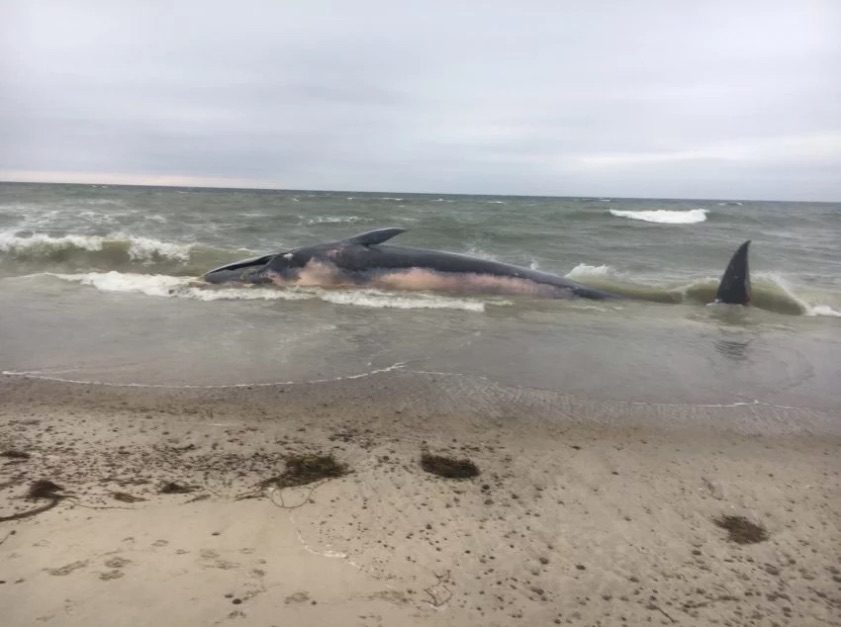A 55-Foot Fin Whale Washed Up on a Massachusetts Beach. What Killed It?

A finback whale that died near the coast of Massachusetts has unwittingly donated its body to science.
On Monday (Aug. 20), the Duxbury Police Department posted on Twitter to ask the public to avoid Duxbury Beach, where a 55-foot-long (17 meters) whale carcass was resting in the surf. New England Aquarium marine biologists were soon on the scene to necropsy the whale, according to Boston.com. Samples have been sent to labs around the country, said aquarium spokesperson Diana McCloy, but it will be weeks or months before scientists learn anything more about the whale's cause of death.
There's more to the necropsy than just ascertaining why the single animal died, however. Finback whales, also known as fin whales (Balaenoptera physalus), are speedy, elusive swimmers, said Linda Lory, a senior biologist in the rescue department at the New England Aquarium. [Whale Album: Giants of the Deep]
"They are so fast, and they don't breach up like a lot of other whales," Lory told Live Science. That means that stranded carcasses are one of the easier ways to study the animals' anatomy and physiology.
Seeking a cause of death
Lory and her colleagues were on the scene Monday at Duxbury Beach. They used heavy equipment and large knives, including some mounted on long poles, to pull back the whales' blubber — which was over 2 inches (5.8 centimeters) thick in some parts — and sample the muscles and organs beneath. While recording their findings on water-resistant paper, the team also preserved samples for microscopic analysis. They even delved into the whale's stomach, which did contain some undigested food.
"It had been foraging on something at some point," Lory said.
The whale sported old scars from entanglement with fishing lines or nets, the biologists found. That's not very unusual, Lory said. Many of the scars were healed, though one injury on the whale's dorsal, or top, side had dug deep into the blubber. It's not yet clear whether those old injuries had anything to do with the whale's death, Lory said.
Sign up for the Live Science daily newsletter now
Get the world’s most fascinating discoveries delivered straight to your inbox.
Fin-whale facts
Fin whales are the second-largest whales in the world, after blue whales, according to the World Wildlife Fund; the largest individuals can grow to be up to 80 feet (24 m) in length. They are endangered, with between 50,000 and 90,000 left in the wild.
The whales are sometimes called the "greyhounds of the sea" because their sleek frames can speed through the oceans at up to 23 mph (37 km/h), according to the American Cetacean Society. They're found in all but the farthest polar reaches of the world's oceans and subsist on krill and small fish, living alone or in small groups of up to seven individuals.
The remains of the fin whale that washed ashore on Duxbury Beach have already been buried. Data from the samples will be reported to the National Oceanic and Atmospheric Administration, which tracks whale strandings, Lory said. The tissue will be tested not only for viruses and bacteria but also toxins and contaminants that could have contributed to the animal's death. Any unusual findings might hint at larger trends in the overall fin-whale population's health, Lory said.
"We do these, one, to get more information about not just that particular whale," she said, "but also about the whale species as a whole."
Originally published on Live Science.

Stephanie Pappas is a contributing writer for Live Science, covering topics ranging from geoscience to archaeology to the human brain and behavior. She was previously a senior writer for Live Science but is now a freelancer based in Denver, Colorado, and regularly contributes to Scientific American and The Monitor, the monthly magazine of the American Psychological Association. Stephanie received a bachelor's degree in psychology from the University of South Carolina and a graduate certificate in science communication from the University of California, Santa Cruz.









